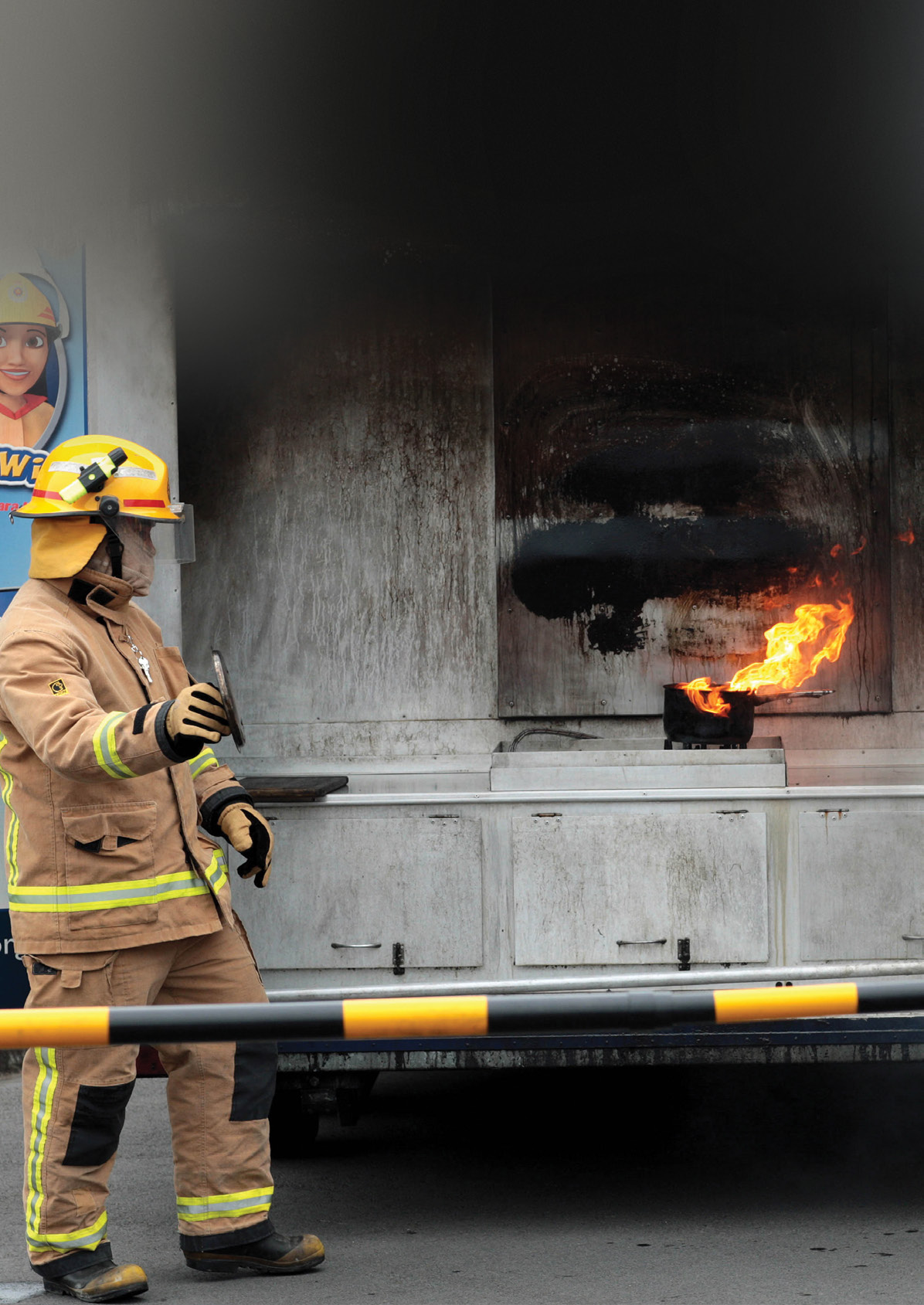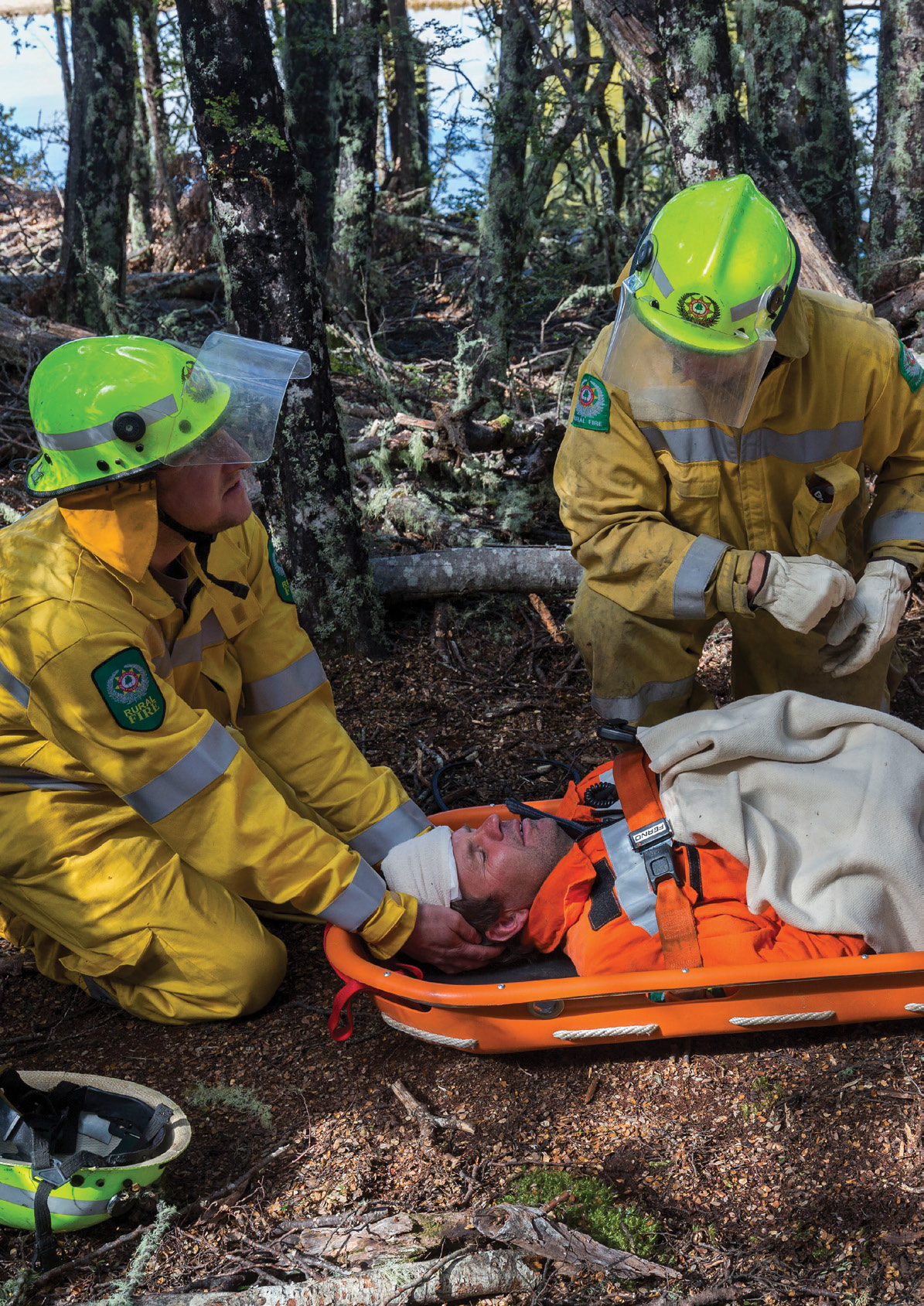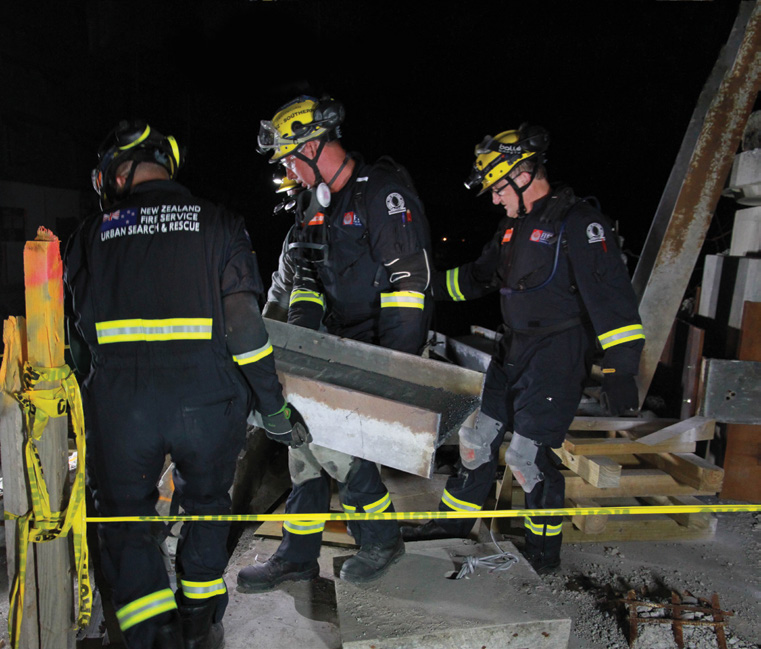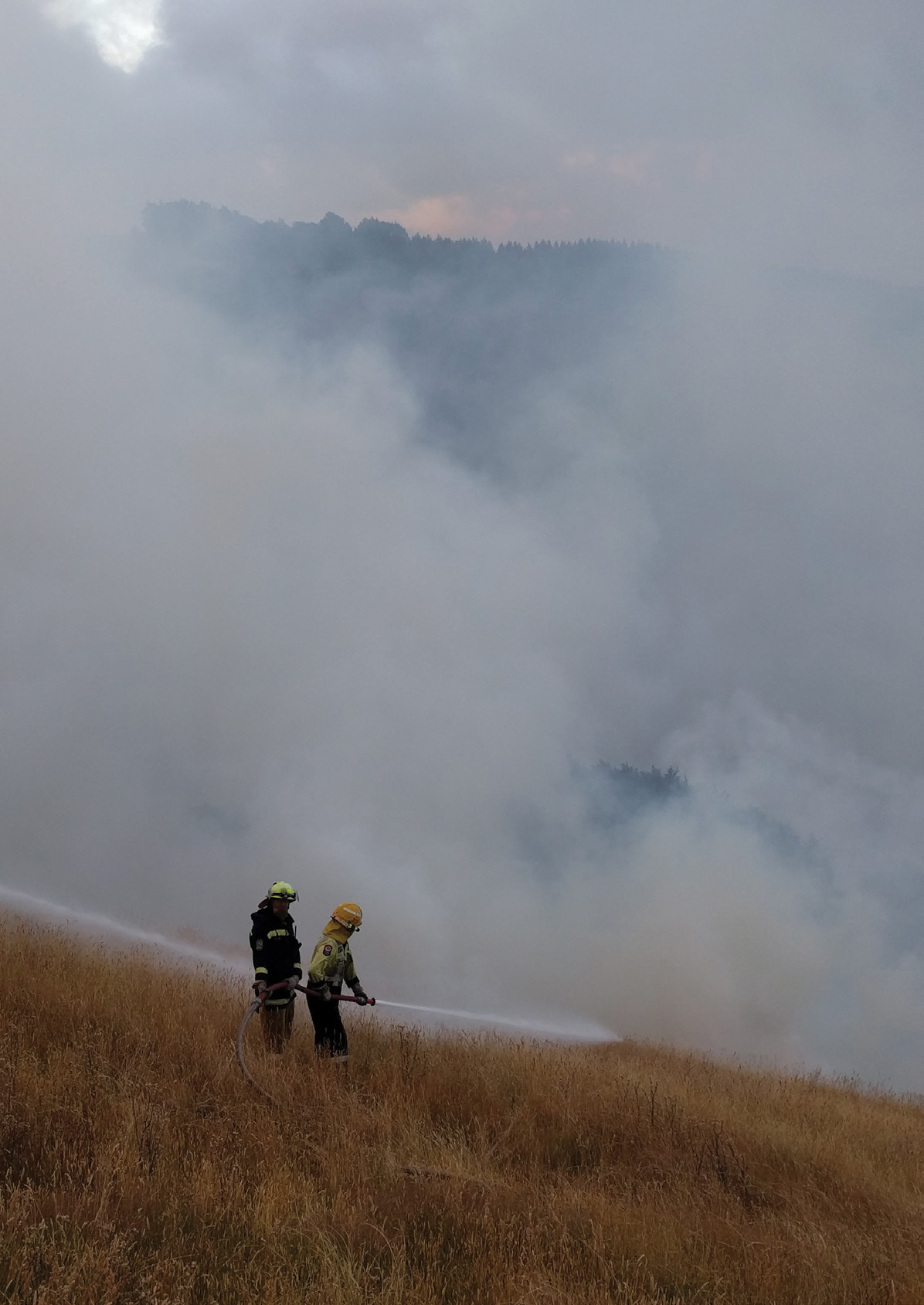
 G8
2017-2018
STATEMENT
OF PERFORMANCE
EXPECTATIONS
G8
2017-2018
STATEMENT
OF PERFORMANCE
EXPECTATIONS
FIRE AND
EMERGENCY
NEW ZEALAND
Tauākī o ngā
taumata mahi hei
whakatutuki
Ratonga ahi
me ngā ohotata
i Aotearoa
under the Official Information Act
Released
PRESENTED TO THE HOUSE OF REPRESENTATIVES PURSUANT TO SECTION 149 OF THE CROWN ENTITIES ACT 2004.
CONTENTS
Ngā kaupapa
Statement of Responsibility
0 1
Introduction
03
Consultation and reporting to the
Minister of Internal Affairs
08
Reportable Outputs
09
Organisational Health and Capability
1 7
Output class reporting
2 0
Financial Statements
2 1
Fire and Emergency New Zealand
Board of Directors
37
under the Official Information Act
Released
ABOUT FIRE AND EMERGENCY NEW ZEALAND
Fire and Emergency New Zealand is a new unified fire organisation that brings together our country’s
urban and rural fire services for the first time. The formation of Fire and Emergency New Zealand
represents a once in a generation opportunity to enable New Zealand to have a fit for purpose 21st
century fire and emergency organisation that is flexible, adaptable and efficient.
www.fireandemergency.nz
FIRE AND EMERGENCY NEW ZEALAND 2017-2018 STATEMENT OF PERFORMANCE EXPECTATIONS
FIRE AND EMERGENCY NEW ZEALAND 2017-2018 STATEMENT OF PERFORMANCE EXPECTATIONS
01

 STATEMENT OF
RESPONSIBILITY
STATEMENT OF
RESPONSIBILITY
Tauākī kawenga
The Statement of Performance Expectations sets out Fire and
Emergency New Zealand’s intended non-financial performance
and financial forecast for the year 1 July 2017 to 30 June 2018,
and should be read in conjunction with the Statement of Intent.
The structure and content of this Statement
The Board acknowledges responsibility
of Performance Expectations follows the
for the preparation of this Statement of
general requirements set out in the Crown
Performance Expectations, which reflects the
Entities Act 2004.
forecast performance and the financial position
of Fire and Emergency New Zealand for the
The Board members and management of Fire
financial year 1 July 2017 to 30 June 2018.
and Emergency New Zealand are responsible for
maintaining systems and processes that support
robust, objective decision-making and compliance
Signature
Signature
with rules, and providing reasonable assurance as
to the integrity and reliability of financial reporting.
Honorable Paul Swain
Dr Nicola Crauford
Chair
Deputy Chair
The performance to be achieved by Fire and
Emergency New Zealand for the year 1 July
2017 to 30 June 2018 specified in this Statement
of Performance Expectations has been agreed
with the Minister for Internal Affairs, who is
responsible for overseeing and managing
the Crown’s interests in Fire and Emergency
under the Official Information Act
New Zealand.
Released
FIRE AND EMERGENCY NEW ZEALAND 2017-2018 STATEMENT OF PERFORMANCE EXPECTATIONS
01

Act
Information
Official
the
under
Released
02
FIRE AND EMERGENCY NEW ZEALAND 2017-2018 STATEMENT OF PERFORMANCE EXPECTATIONS
FIRE AND EMERGENCY NEW ZEALAND 2017-2018 STATEMENT OF PERFORMANCE EXPECTATIONS
03
INTRODUCTION
Kupu whakataki
This Statement of Performance Expectations should be read in
Act
conjunction with the Fire and Emergency New Zealand Statement
of Intent 2017-2021, which provides the strategic direction and
priorities for the organisation.
WHAT WE DO: FIRE AND
These include responding to:
EMERGENCY NEW ZEALAND’S
• medical emergencies
OBJECTIVES AND FUNCTIONS
Information
• maritime incidents
Our main objectives are to:
• other rescues
• reduce unwanted fires
• weather events and disasters
• protect and preserve life, prevent or limit
• incidents where substances present a risk
injury, and prevent or limit damage to
to people, property, or the environment
property, land and the environment.
• any other situation where we can assist.
Official
Fire and Emergency New Zealand will seek
to achieve these objectives through our
ADDITIONAL PROVISIONS
the
main and additional functions.
In addition, the Act provides for local advisory
committees to provide local input into our national
The Fire and Emergency New Zealand Act
planning, ensuring that it is responsive to the risks
2017 (the Act) sets out the “main functions”
and needs of communities.
we must do including: under
• fire safety (including guidance on the
The Act provides an initial transitional levy
period during which we will be funded from the
safe use of fire as a land management tool)
same levy base as under the Fire Service Act
and firefighting
1975. Following the transitional period there will
• responding to hazardous substance incidents
be a broadened levy base to reflect the range
• rescuing trapped people
of services that we provide. The levy represents
around 95% of our funding. In addition, there
• urban search and rescue.
will be new measures to encourage compliance
Released
among levy payers, and to protect the integrity of
The Act includes “additional functions”
the levy. We will consult the public on the levy rate
we may do if we have capability and capacity,
and our proposed activities at least every three
and provided this does not affect our ability
years, making our funding more transparent
to carry out our main functions.
and aligned to strategic priorities.
FIRE AND EMERGENCY NEW ZEALAND 2017-2018 STATEMENT OF PERFORMANCE EXPECTATIONS
03
The Act also provides for a range of measures for
In formulating these principles, we must
Act
our detailed design and operation. This will enable
take into account:
us to provide fire and emergency services that are
• the importance of evidence-based,
flexible, up-to-date, effective and efficient, that
efficient and effective services
are funded appropriately, and that value the paid
• local interests and differences
and volunteer workforce. These measures include:
• the importance of transparency
• a framework for supporting volunteers,
based on modern volunteer principles
• the importance of engagement with
personnel, local advisory committees,
• penalties and offences provisions
and relevant organisations.
• a disputes resolution scheme
Information
• a code of practice to ensure the adequacy
of firefighting water supplies
HOW WE OPERATE
• updated provisions for evacuation schemes.
Fire and Emergency New Zealand was established
in July 2017 following the enactment of the Fire
As a Crown entity, we must also comply with
and Emergency New Zealand Act. It combines
the Crown Entities Act 2004 and all relevant
urban and rural fire services into a single, unified
Official
legislation.
fire services organisation, and expanded functions
that reflect the wide range of services firefighters
provide for communities. To a large degree, this
the
FIRE AND EMERGENCY NEW
wider mandate brings into law what has already
ZEALAND’S APPROACH
been an operational reality.
The Act provides a framework within which to
deliver our functions. We are required to develop
operating principles to guide and assist us to:
TRANSITION PERIOD 2017 – 2020
under
• carry out our functions effectively
A realistic three-year integration programme
and in a coordinated manner
has been designed to ensure that Fire and
• work co-operatively and collaboratively
Emergency New Zealand can respond safely
with other organisations
and effectively to emergencies from 1 July 2017,
• consult effectively with stakeholders.
while delivering the work required to realise the
benefits of the new organisation and give
effect to the new legislation.
Released
04
FIRE AND EMERGENCY NEW ZEALAND 2017-2018 STATEMENT OF PERFORMANCE EXPECTATIONS
FIRE AND EMERGENCY NEW ZEALAND 2017-2018 STATEMENT OF PERFORMANCE EXPECTATIONS
05
OUTCOMES FRAMEWORK
The Outcomes Framework (shown below) represents a high-level view of our Impacts Framework.
This framework demonstrates the relationships between the outputs, impacts and outcomes and
graphically represents the process by which the organisation creates value for New Zealand.
Act
GOVERNMENT
BETTER PUBLIC SERVICES THAT ALL
PRIORITY
NEW ZEALANDERS RELY ON
OUTCOMES
Information
REDUCE LIKELIHOOD
INCREASE COMMUNITY
REDUCE CONSEQUENCES
OF UNWANTED FIRE
RESILIENCE
FROM EMERGENCIES
IMPACTS
Official
the
BUILDINGS ARE SAFER
RECOVERY FROM MAJOR
HARM FROM FIRE IS REDUCED
DISASTER EVENT IS SWIFTER
PUBLIC SAFETY
MEDICAL TREATMENT
BEHAVIOUR IS
COMMUNITIES BETTER
IS EXPEDITED
ENHANCED
ABLE TO MANAGE MAJOR
EMERGENCIES
HARM TO ENVIRONMENT
FROM HAZARDOUS
SUBSTANCES IS REDUCED
under
PRODUCTS
& SERVICES
ADVICE TO INDUSTRY AND
SPECIALIST DISASTER RECOVERY
TIMELY AND PROFESSIONAL
COUNCIL ON BUILDING DESIGN
FOLLOWING MAJOR EMERGENCIES
RESPONSE TO ALL FIRES
Released
FIRE SAFETY EDUCATION
NETWORK OF TRAINED
TIMELY AND PROFESSIONAL
TO THE PUBLIC
EMERGENCY RESPONDERS
RESPONSE TO OTHER
ACROSS NEW ZEALAND
EMERGENCIES
FIRE PERMITTING AND
ENFORCEMENT
URBAN SEARCH AND RESCUE
ORG HEALTH
SAFETY, HEALTH AND WELLBEING • PEOPLE • FINANCE
& CAPABILITY
ICTS • TRAINING • BUSINESS EFFECTIVENESS
04
FIRE AND EMERGENCY NEW ZEALAND 2017-2018 STATEMENT OF PERFORMANCE EXPECTATIONS
FIRE AND EMERGENCY NEW ZEALAND 2017-2018 STATEMENT OF PERFORMANCE EXPECTATIONS
05
OUR STRATEGIC PRIORITIES
FIRE REDUCTION AND PREVENTION
Act
Our Statement of Intent 2017-2021 identifies
We will build our capability to deliver effective
five priorities that will be the focus for Fire and
community risk reduction activities to prevent
Emergency New Zealand over the next four
unwanted fires and provide guidance on fire
years. The first three of the priorities reflect our
risk reduction and prevention.
commitment to delivering better outcomes for
New Zealanders through the services we deliver:
STRONGER ENGAGEMENT WITH COMMUNITIES
• Fire risk reduction and prevention
Engaging and connecting with our communities
will enable us to identify and provide services that
• Stronger engagement with communities
are appropriate to community risks and needs.
• Coordinated services.
Information
COORDINATED SERVICES
The final two priorities are focused on creating
Coordinated services will help ensure improved
the right environment within Fire and Emergency
readiness for and response to incidents.
New Zealand to ensure that we can maximise
We will build capacity and capability in a range
the impact we deliver for New Zealanders:
of areas. This will enhance coordination within
• Building and shaping Fire and Emergency
Fire and Emergency New Zealand and with
Official
New Zealand
other emergency services.
• Developing a shared identity.
BUILDING AND SHAPING FIRE
the
Our strategic priorities operate within the
AND EMERGENCY NEW ZEALAND
context of the Outcomes Framework and seek
We will be a fit for purpose, 21st century fire
to lift our performance by improving the quantity
and emergency service that is well led, has
and quality of our products and services, and
a valued and supported workforce and enjoys
enhancing our impact. This is illustrated by the
the confidence and trust of communities and
under
strategy map on the following page.
other stakeholders.
The nature of the activities we will undertake
DEVELOPING A SHARED IDENTITY
in support of each strategic priority and the
Merging 40 organisations, each with their
benefits we expect to realise from each
own history and culture, requires us to connect
priority are:
our people under a unifying identity which
recognises what we all have in common
and values what is different.
Released
06
FIRE AND EMERGENCY NEW ZEALAND 2017-2018 STATEMENT OF PERFORMANCE EXPECTATIONS
FIRE AND EMERGENCY NEW ZEALAND 2017-2018 STATEMENT OF PERFORMANCE EXPECTATIONS
07
STRATEGY MAP
OUTCOMES
Act
REDUCE LIKELIHOOD
INCREASE COMMUNITY
REDUCE CONSEQUENCES
ORGANISATIONAL HEALTH
OF UNWANTED FIRE
RESILIENCE
FROM EMERGENCIES
AND CAPABILITY
IMPACTS
Information
BUILDINGS ARE
RECOVERY FROM
HARM FROM FIRE IS REDUCED
SAFER
MAJOR DISASTER EVENT
MEDICAL TREATMENT
PUBLIC SAFETY
IS SWIFTER
IS EXPEDITED
BEHAVIOUR IS
COMMUNITIES
HARM TO ENVIRONMENT
ENHANCED
BETTER ABLE TO MANAGE
FROM HAZARDOUS
MAJOR EMERGENCIES
SUBSTANCES IS REDUCED
STRATEGIC
Official
IMPACTS
the
GREATER
SERVICES BETTER
IMPROVED
EFFECTIVE LEADERSHIP
EMPHASIS ON AND
TAILORED TO
READINESS FOR AND
AND GOVERNANCE
EFFECTIVENESS OF FIRE
COMMUNITY NEEDS
QUALITY OF RESPONSE
ENHANCED EFFECTIVENESS
RISK REDUCTION
AND RISKS
TO INCIDENTS
AND EFFICIENCY
under
GREATER SENSE OF
ENGAGEMENT AND BELONGING
STRATEGIC
PRIORITIES
Released
FIRE REDUCTION
STRONGER ENGAGEMENT
COORDINATED
BUILDING AND
AND PREVENTION
WITH COMMUNITIES
SERVICES
SHAPING FIRE AND EMERGENCY
NEW ZEALAND
DEVELOPING A
SHARED IDENTITY
We will monitor progress toward our outcomes using the specific measures and targets set out in this
Statement. Both the Outcomes Framework and the strategic priorities will provide the basis for key
performance indicators and individual performance measures for all our people.
06
FIRE AND EMERGENCY NEW ZEALAND 2017-2018 STATEMENT OF PERFORMANCE EXPECTATIONS
FIRE AND EMERGENCY NEW ZEALAND 2017-2018 STATEMENT OF PERFORMANCE EXPECTATIONS
07
CONSULTATION AND
REPORTING TO THE MINISTER
OF INTERNAL AFFAIRS
Te Kōrerotahi me te
whakaputanga ā-pūrongo
ki te Minita
Act
CONSULTATION WITH THE MINISTER
The Board is committed to a “no surprises policy” for new initiatives, operational events and overall
policies. The Board will provide its responsible Minister with accurate, relevant, complete and timely
Information
information to ensure the Minister’s decisions and responsibilities with respect to Fire and Emergency
New Zealand can be carried out on a fully informed basis.
REPORTING TO THE MINISTER
The Board will provide quarterly progress reports to the Minister against its key priorities and initiatives,
Official
the service, and financial performance expectations set out in this Statement and other information as
required. The quarterly reports will be provided within the following timeframes:
the
QUARTER
TIMEFRAME – NO LATER THAN
1 July 2017 to 30 September 2017
3 November 2017
1 October 2017 to 31 December 2017
2 March 2018
under
1 January 2018 to 31 March 2018
4 May 2018
1 April 2018 to 30 June 2018
3 August 2018
Released
08
FIRE AND EMERGENCY NEW ZEALAND 2017-2018 STATEMENT OF PERFORMANCE EXPECTATIONS
FIRE AND EMERGENCY NEW ZEALAND 2017-2018 STATEMENT OF PERFORMANCE EXPECTATIONS
09
REPORTABLE OUTPUTS
Ngā whakaputanga
ā-pūrongo
FIRE AND EMERGENCY
Subject to an annual application, additional funding Act
NEW ZEALAND TRANSITION
has been made available through a capital injection
to support Fire and Emergency New Zealand to
WHAT IS IT INTENDED TO ACHIEVE?
deliver a three year programme of integration.
A successful transition into Fire and Emergency
New Zealand of functions previously undertaken by
Measures that are highlighted in orange
40 separate organisations. Above all, successful
throughout this Statement of Performance
transition requires that emergency services
Expectations have been specifically identified as
continue to be provided on Day One of the new
Transition based and will be used to report against
organisation and beyond without interruption.
progress of the integration.
Information
REDUCED LIKELIHOOD OF UNWANTED FIRES
WHAT IS IT INTENDED TO ACHIEVE?
Preventing unwanted fires from occurring, and authorised and managed fires from getting out of
control, through leading an enhanced programme of research, education, community engagement,
compliance and advice.
Official
ACTIVITIES UNDER THIS OUTPUT
the
ADVICE TO INDUSTRY AND COUNCILS ON BUILDING DESIGN
Core services
ACTIVITY
MEASURE OF SUCCESS
Undertake fire engineering assessments
1.1.1
All assessments are processed within
under
during the design phase of new buildings.
10 working days.
Administer the fire safety and evacuation of
1.1.2
All applications for evacuation schemes
buildings regulation, ensuring schemes provide
are processed within 20 working days.
for the safe evacuation of people during a
fire emergency.
Action to support our strategic priorities
Released
ACTIVITY
MEASURE OF SUCCESS
Develop a risk score tool that measures the
1.2.1
Risk score tool designed by
impact of Fire and Emergency New Zealand’s
31 March 2018.
advice on building design, in relation to the
overall safety level of the building.
08
FIRE AND EMERGENCY NEW ZEALAND 2017-2018 STATEMENT OF PERFORMANCE EXPECTATIONS
FIRE AND EMERGENCY NEW ZEALAND 2017-2018 STATEMENT OF PERFORMANCE EXPECTATIONS
09
FIRE SAFETY EDUCATION TO THE PUBLIC
Act
Core services
ACTIVITY
MEASURE OF SUCCESS
Deliver a suite of targeted fire education
2.1.1
90% of people surveyed are aware that
programmes that resonate with audiences
a house fire can become fatal within five
and promote fire reduction and prevention.
minutes.
Deliver Fire Awareness Intervention Programme
2.1.2 FAIP is offered in 95% of incidents involving
(FAIP) – an education programme that is delivered
5-17 year olds when they are able to be
Information
by trained firefighters to address unhealthy fire-
identified.
lighting behaviour by children and young people
2.1.3 Recidivism rate among FAIP recipients is
(5–17 year olds).
below 10%.
Undertake fire education nationwide through
2.1.4 FireWise programme is offered to 100%
schools to ensure that acting fire wise is
of schools with year 1 and 2 students over
imparted early with our young people.
a two-year period.
Official
2.1.5 60% of schools with year 1 and 2 students
undertake the FireWise programme over
a two-year period.
the
Develop a research strategy aligned to the
2.1.6 Research strategy developed and in place
organisation’s priorities, and fund and facilitate a
by 30 June 2018.
research programme, which leads to improvement
2.1.7 80% of research funding is allocated
in understanding and activities relating to fire
to projects aligned to organisational
under
and emergency prevention and response.
priorities.
Released
10
FIRE AND EMERGENCY NEW ZEALAND 2017-2018 STATEMENT OF PERFORMANCE EXPECTATIONS
FIRE AND EMERGENCY NEW ZEALAND 2017-2018 STATEMENT OF PERFORMANCE EXPECTATIONS
11
Action to support our strategic priorities
Act
ACTIVITY
MEASURE OF SUCCESS
Review and fully integrate a fire safety
2.2.1 Integrated fire safety strategy is in place
strategy, including programmes tailored for
by 30 June 2018.
New Zealand’s diverse communities, and an
2.2.2 Process for reviewing future fire safety
enhanced fire safety promotion programme.
promotion programme is in place
by 30 June 2018.
Engage with stakeholders and communities,
2.2.3 Local planning process designed
including those disproportionately impacted by
by 30 June 2018.
Information
fire, on the local fire planning process to achieve
a holistic approach to local risk management.
Develop effective guidance on the safe use
2.2.4 Guidance on safe fire use is in place
of fire as a land management tool.
by 31 December 2017.
2.2.5 By 30 June 2018, 80% of surveyed
Official
stakeholders agree that guidance is fit
for purpose.
the
FIRE ADVICE, PERMITTING AND ENFORCEMENT
Core services
ACTIVITY
MEASURE OF SUCCESS
Act as an advocate and subject matter
3.1.1
Provide at least three case studies by
under
expert organisation on relevant aspects
30 June 2018 where Fire and Emergency
of the government policy and legislative
New Zealand has provided advice and
change programme.
information on relevant aspects of the
government policy and legislative
change programme.
Action to support our strategic priorities
Released
ACTIVITY
MEASURE OF SUCCESS
Develop a compliance and enforcement strategy.
3.2.1 Compliance and enforcement strategy
in place by 30 June 2018.
Embed a national online fire permitting system
3.2.2 Fire permitting system implemented
which is easy to use and effective for ourselves
by 30 June 2018.
and our communities.
10
FIRE AND EMERGENCY NEW ZEALAND 2017-2018 STATEMENT OF PERFORMANCE EXPECTATIONS
FIRE AND EMERGENCY NEW ZEALAND 2017-2018 STATEMENT OF PERFORMANCE EXPECTATIONS
11
REDUCED CONSEQUENCES FROM EMERGENCIES
Act
WHAT IS IT INTENDED TO ACHIEVE?
Being a trusted responder to incidents by leading or supporting others to minimise the impact
on people, property and the environment. Ensuring that risks to people are managed through
clear accountability, capability development and appropriate resourcing.
ACTIVITIES UNDER THIS OUTPUT
TIMELY AND PROFESSIONAL RESPONSE TO FIRES
Information
Core services
ACTIVITY
MEASURE OF SUCCESS
Responding to fires
4.1.1
Career crews respond to 85%1 of structure
fires (excluding Private Fire Alarm (PFA)
false alarms) within eight minutes.
Official
4.1.2 Urban volunteer crews respond to 85%
of structure fires (excluding PFA false
alarms) within 11 minutes.
the 4.1.3 Record the number of fires responded
to by rural fire forces.2
Action to support our strategic priorities
under
ACTIVITY
MEASURE OF SUCCESS
Identify gaps in operational equipment, technology
4.2.1 Gap analysis and investment plan
and training and begin making targeted
complete for fleet, property, equipment
investment to address these.
and training requirements by 30 June
2018.
Released
1 The percentage targets for Fire and Emergency New Zealand are lower than previous similar targets for the New Zealand
Fire Service. These targets did not provide a useful indicator of organisational performance and in most cases were not
achieved. The current measures are based on actual performance and are a more reliable indicator of what response
times can be expected, based on the resourcing and footprint of Fire and Emergency New Zealand. New measures
will be developed in 2017/18.
2 New measures for response by rural fire forces will be developed during 2017/18, as integrated rural data becomes available.
12
FIRE AND EMERGENCY NEW ZEALAND 2017-2018 STATEMENT OF PERFORMANCE EXPECTATIONS
FIRE AND EMERGENCY NEW ZEALAND 2017-2018 STATEMENT OF PERFORMANCE EXPECTATIONS
13
TIMELY AND PROFESSIONAL RESPONSE TO OTHER EMERGENCIES
Act
Core services
ACTIVITY
MEASURE OF SUCCESS
Motor vehicle crashes
5.1.1
Crews from specialist resource locations
respond to 90% of motor vehicle crashes
within 30 minutes.
5.1.2 Record the number of motor vehicle
crashes responded to by rural fire fighters.
Information
Medical emergencies
5.2.1 Career crews respond to 85% of medical
emergencies within eight minutes.
5.2.2 Urban volunteer crews respond to 85% of
medical emergencies within 11 minutes.
5.2.3 Record the number of medical emergencies
responded to by rural fire forces.
Official
Hazardous substances incidents
5.3.1 Crews from specialist resource locations
respond to 85% of hazardous substances
the incidents within 60 minutes.
Action to support our strategic priorities
ACTIVITY
MEASURE OF SUCCESS
under
Establish a high level of engagement with
5.4.1 Achieve an annual external stakeholder
emergency sector partners and other relevant
engagement survey score of 7.8/10
agencies which achieves greater coordination
or better.
within the sector.
Released
12
FIRE AND EMERGENCY NEW ZEALAND 2017-2018 STATEMENT OF PERFORMANCE EXPECTATIONS
FIRE AND EMERGENCY NEW ZEALAND 2017-2018 STATEMENT OF PERFORMANCE EXPECTATIONS
13
INCREASED COMMUNITY RESILIENCE
Act
WHAT IS IT INTENDED TO ACHIEVE?
Maintaining a strong local presence and improved services, supported by a national organisation that
is responsive to risks and needs. This will help ensure that communities have the capability to prevent
and respond to emergencies.
ACTIVITIES UNDER THIS OUTPUT
SPECIALIST DISASTER RECOVERY FOLLOWING MAJOR EMERGENCIES
Information
Core services
ACTIVITY
MEASURE OF SUCCESS
Provide a skilled and specialist response to
6.1.1
Establish a baseline of the number of
severe weather-related events, natural hazard
personnel trained to CAT1R3 in urban
events and disasters.
search and rescue (USAR).
Official
6.1.2 Report following annual exercise shows
USAR operating at full effectiveness.
the
AN ENGAGED AND EQUIPPED NETWORK OF COMMUNITIES ACROSS NEW ZEALAND
Core services
ACTIVITY
MEASURE OF SUCCESS
Provide essential emergency response
7.1.1
90% of the New Zealand population
under
capabilities to all New Zealand communities.
is within nine minutes drive-time
from a station.
Released
3 CAT1R is a general qualification issued to Fire and Emergency New Zealand personnel that meet the requirements for
a core level of awareness and response capability in urban search and rescue.
14
FIRE AND EMERGENCY NEW ZEALAND 2017-2018 STATEMENT OF PERFORMANCE EXPECTATIONS
FIRE AND EMERGENCY NEW ZEALAND 2017-2018 STATEMENT OF PERFORMANCE EXPECTATIONS
15

 Action to support our strategic priorities
Action to support our strategic priorities
Act
ACTIVITY
MEASURE OF SUCCESS
Publish a statement about how we will support
7.2.1 Statement published by 30 June 2018.
the Crown in its Treaty of Waitangi relationships,
to help support and improve our engagement with
and relevant outcomes for Māori.
Design a structure and approach for local advisory
7.3.1 At least one trial LAC is operating
committees (LAC) so they are able to engage
by 31 March 2018.
on behalf of their communities and effectively
7.3.2 Recommendations stemming from trial LAC
Information
identify risks and needs. Establish at least one
have been developed by 30 June 2018.
trial local advisory committee, based on pilots.
7.3.3 By 31 May 2018, 80% of surveyed
stakeholders involved in the trial LAC
process indicate it was well run and that
their views were heard.
Official
Undertake public consultation to determine local
7.4.1 Public consultation is completed
advisory committee boundaries.
by 30 June 2018.
the
under
Released
14
FIRE AND EMERGENCY NEW ZEALAND 2017-2018 STATEMENT OF PERFORMANCE EXPECTATIONS
FIRE AND EMERGENCY NEW ZEALAND 2017-2018 STATEMENT OF PERFORMANCE EXPECTATIONS
15

Act
Information
Official
the
under
Released
16
FIRE AND EMERGENCY NEW ZEALAND 2017-2018 STATEMENT OF PERFORMANCE EXPECTATIONS
FIRE AND EMERGENCY NEW ZEALAND 2017-2018 STATEMENT OF PERFORMANCE EXPECTATIONS
17
ORGANISATIONAL
HEALTH AND CAPABILITY
Te kaha me te hauora
whakahaere
WHAT IS IT INTENDED TO ACHIEVE?
Act
The focus for Fire and Emergency New Zealand as it establishes itself as a new organisation is to ensure that
the systems, processes and culture support our personnel to do their best for New Zealanders every day.
There are a significant number of processes and systems that need to be transitioned and integrated
into Fire and Emergency New Zealand and this will be a key focus in 2017/18 to ensure we can continue
to deliver our services well.
To deliver on its objectives and the intentions of the reform, Fire and Emergency New Zealand will foster
an inclusive, team-based, safety conscious culture with a workforce that reflects the diversity of the
Information
communities in which it serves.
ACTION TO SUPPORT OUR STRATEGIC PRIORITIES
ACTIVITY
Official
Design an operating model that:
8.1.1
Draft operating model completed
• Establishes our operating principles
by 30 June 2018.
• Sets out how the new organisation will work
the
• Describes a flexible operational function with
a strategic and well-run corporate function
• Identifies the skills and knowledge our people
need for Fire and Emergency New Zealand to
achieve its mission under
• Includes a performance measurement, monitoring
and reporting framework that supports greater
transparency and improved decision-making.
• Describes tools for the organisation to ensure
that our people are well engaged in decision
making for the business.
Released
FIRE AND EMERGENCY NEW ZEALAND 2017-2018 STATEMENT OF PERFORMANCE EXPECTATIONS
17
Act
ACTIVITY
Undertake an engagement survey to provide
8.1.2 Engagement survey run and baseline
a baseline measurement
target established by 30 June 2018.
Undertake consultation with the public and key
8.1.3 Public consultation on levy rates
stakeholders to provide analysis to the Department of
completed by 31 March 2018.
Internal Affairs to support recommendations to cabinet
on the next levy rates.
Develop our volunteer strategy and commence
8.1.4 Volunteer strategy developed by
Information
implementation of the associated prioritised
31 March 2018.
work programmes based on contemporary
8.1.5 Published year one volunteer initiatives
volunteer principles.
are delivered by 30 June 2018.
Administer an interim issues process for
8.1.6 Conduct a preliminary review of the interim
volunteers and capture the learnings to inform
process by 31 December 2017. Findings of
Official
the future statutory disputes resolution scheme.
preliminary review to feed into future-state
disputes resolution model.
Develop health standards and associated support
8.1.7 Health standards and associated support
the
processes to support the safety, health and
processes developed by 30 June 2018.
wellbeing of our people.
Develop a recognition strategy for volunteer
8.1.8 Priority components of the recognition
personnel, including a uniform approach to
strategy identified and implementation
under
volunteer reimbursements and payments.
commenced by 30 June 2018.
Released
18
FIRE AND EMERGENCY NEW ZEALAND 2017-2018 STATEMENT OF PERFORMANCE EXPECTATIONS
FIRE AND EMERGENCY NEW ZEALAND 2017-2018 STATEMENT OF PERFORMANCE EXPECTATIONS
19
Act
ACTIVITY
Engage with our people to develop the vision and
8.1.9 Engagement process completed
values that will underpin Fire and Emergency
by 30 June 2018.
New Zealand and shape our identity.
Design and implement methodologies to identify
8.1.10 Complete pilots of the Strategic Leader
and develop current and future leaders of Fire
and Senior Leader programmes by 30
and Emergency New Zealand.
March 2018.
Develop a strategy for an inclusive culture that
8.1.11 Inclusive culture strategy is in place by 31
Information
promotes a supportive environment and fosters
March 2018. All levels of the organisation
diversity within our workforce.
have been consulted on its development.
Develop a comprehensive brand strategy to fully
8.1.12 Brand strategy developed by
implement all elements of our identity.
30 December 2017.
Official
Reduce the number of staff workplace injuries
8.1.13 Number of staff workplace injuries
requiring more than seven days off work.
requiring more than seven days off work,
less than 134.4
the
4 Figure based on a four-year average for New Zealand Fire Service. The measure will be refined as rural employees’ health
and safety information is migrated to Fire and Emergency New Zealand, and information becomes available on injury rates
across the whole organisation.
under
Released
18
FIRE AND EMERGENCY NEW ZEALAND 2017-2018 STATEMENT OF PERFORMANCE EXPECTATIONS
FIRE AND EMERGENCY NEW ZEALAND 2017-2018 STATEMENT OF PERFORMANCE EXPECTATIONS
19
OUTPUT CLASS
REPORTING
Act
FORECAST
FORECAST
FORECAST
NET
LEVY
OTHER
TOTAL
SURPLUS/
$000 GST excl
RECEIPTS
REVENUE EXPENDITURE
(DEFICIT)
1.0 Reduced likelihood of unwanted fires
77,749
2,878
69,242
11,385
1.1 Advice to industry and councils on building
1,955
500
1,601
854
design
1.2 Fire safety education to the public
32,266
1,036
30,147
3,155
1.3 Fire advice, permitting and enforcement
43,528
1,343
37,494
7,377
Information
2.0 Reduced consequences from emergencies
417,654
13,118
381,890
48,882
2.1 Timely and professional response to all fires
317,078
8,932
260,036
65,974
2.2 Timely and professional response
100,576
4,186
121,854
(17,092)5
to other emergencies
3.0 Increased community resilience
22,713
764
19,320
4,157
Official
3.1 Specialist disaster recovery following
22,713
764
19,320
4,157
major emergencies
the
3.2 An engaged and equipped network of
communities across New Zealand6
4.0 Integration activities supported
–
–
28,293
(28,293)
by payable capital injection
under
518,116
16,760
498,745
36,131
Released
5 This amount signifies an under recovery on motor vehicles.
6 This output does not have any direct cost associated to it as it encapsulates all the costs
of FIre and Emergency New Zealand which are included in the other outputs.
20
FIRE AND EMERGENCY NEW ZEALAND 2017-2018 STATEMENT OF PERFORMANCE EXPECTATIONS
FIRE AND EMERGENCY NEW ZEALAND STATEMENT OF PERFORMANCE 2017 – 2021
21
 FINANCIAL
STATEMENTS
FINANCIAL
STATEMENTS
Ngā tauākī pūtea
FOR THE YEAR ENDED
30 JUNE 2018
Act
Information
Official
the
CONTENTS
under
Ngā kaupapa
Introduction 22
Statement of Comprehensive
Revenue and Expenditure
24
Released
Statement of Changes in Equity
25
Statement of Financial Position
26
Statement of Cash Flows
27
Notes to the Financial Statements
28
Statement of Accounting Policies
30
20
FIRE AND EMERGENCY NEW ZEALAND 2017-2018 STATEMENT OF PERFORMANCE EXPECTATIONS
FIRE AND EMERGENCY NEW ZEALAND STATEMENT OF PERFORMANCE 2017 – 2021
21

 INTRODUCTION
To ensure Fire and Emergency New Zealand are ready to respond to
INTRODUCTION
To ensure Fire and Emergency New Zealand are ready to respond to
Act
incidents and deliver effective services, we incur a high proportion of
fixed costs in personnel, property and equipment. Contrasted against
this largely steady expenditure, our funding model means that income
is not evenly spread across the year.
Taken together, the steady expenditure and
To provide confidence that our expenditure is
variable income mean that careful cash-flow
appropriate and being carefully managed, levy
management is a high priority. Cash, investments
setting will be subject to public consultation
Information
and other banking and financing facilities are
at least every three years. Feedback received
used to cover fluctuations in the difference
during the public consultation process will be
between income and expenditure. Additional new
taken into account when completing the analysis
borrowing options continue to be explored to
that underpins proposals to Cabinet on the
manage in this environment.
levy rates. Beyond the levy rates themselves,
our levy income is affected by a number of
Official
The difference between the cash basis required
factors including the growth in residential and
to manage our finances on a day-to-day basis
commercial construction, changes in motor
and the accrual accounting required under the
vehicle numbers, the types of insurance policies
formal standards for financial statements can
organisations enter into, and levy exemptions.
the
lead to what appears to be significant budget
In this context, as we transition to the new
surpluses. The variation between accrual and
funding base, there are additional complexities
cash accounting are detailed further in the
in forecasting income. To mitigate this, we are
financial notes on page 28.
developing a more detailed estimation model
in consultation with the insurance industry, and
under
Our services are funded primarily through a
continue to carefully analyse actual data as it
levy on property and motor vehicle insurance,
becomes available.
supplemented by a government contribution for
public good7 and direct charging for a small set of
services. To better reflect the scope of activities
we undertake, the Government has decided to
broaden the base of the levy from insurance for
fire. From 1 January 2019, the levy will apply to all
insurance for material damage (damage through
Released
fire, flood, burglary, earthquake or similar events)
and third-party motor vehicle insurance.
7 That is, for costs associated with medical emergencies, services to the public and police, rescue and other emergencies,
domestic and commercial water services, and wider emergency management.
22
FIRE AND EMERGENCY NEW ZEALAND 2017-2018 STATEMENT OF PERFORMANCE EXPECTATIONS




While we continue to provide core services, over
Budget forecasts are based on what is currently Act
the next four years we are working to build a
known about levy income, operating costs and
fit-for-purpose fire and emergency organisation
the investment we require in our initial period
that is flexible, adaptable and efficient. The
of operation. While we have a high degree of
Government has recognised that this is not a
confidence for the 2017/18 budget, there is some
simple or quick task. To fully achieve the intent of
uncertainty in the forecasts for 2018/19 and
the reforms and deliver the outcomes desired will
2019/20. There is therefore likely to be some
take time and a number of years to implement.
variation in subsequent years’ Statements of
Government approved specific funding to June
Performance Expectations as we refine our
2021 for this purpose with a repayable transition
priorities, better understand the investments
capital injection of up to $111.94 million over
required to update our assets and create a new
Information
four years. Annual repayments of this transition
operating model, and address the implications
funding will also need to be factored in to our
of the new levy base and the resulting decisions
cash-flow management.
on the levy rate.
Official
the
under
Released
22
FIRE AND EMERGENCY NEW ZEALAND 2017-2018 STATEMENT OF PERFORMANCE EXPECTATIONS
FIRE AND EMERGENCY NEW ZEALAND 2017-2018 STATEMENT OF PERFORMANCE EXPECTATIONS
23
STATEMENT OF
COMPREHENSIVE
REVENUE AND
EXPENDITURE
For the years ending 30 June
Act
BUDGET
FORECAST
FORECAST
2017/18
2018/19
2019/20
$000
$000
$000
Revenue
Levy
518,116
498,729
503,895
Interest revenue
925
446
202
Other revenue
15,835
15,685
15,635
Total revenue
534,876
514,860
519,732
Expenditure
Information
Employee and volunteer benefits expenditure
322,891
322,128
328,770
Depreciation
41,377
48,084
56,183
Amortisation
3,337
3,652
4,320
Finance costs
689
955
843
Other expenditure
120,626
114,438
118,403
Official
Campaign fires
9,825
9,825
9,825
Total expenditure
498,745
499,082
518,344
the
Net surplus attributable to Fire and Emergency New Zealand
36,131
15,778
1,388
Other comprehensive income
Gains on revaluation of land and buildings net of impairment losses
14,784
15,227
15,684
Total comprehensive income attributable to the owners
50,915
31,005
17,072
under
of Fire and Emergency New Zealand
* Other expenditure
Fleet
18,400
18,991
19,564
Communications and computer
25,836
25,541
25,541
Occupancy
20,810
21,066
20,911
Operational clothing, equipment and consumables
18,373
15,749
18,277
Released
Travel
12,810
11,092
12,845
Promotional Activities
6,746
6,676
6,676
Other
17,651 8
15,323
14,589
Total other expenditure
120,626
114,438
118,403
8 In 17/18, this is made up of professional fees $7.1m, grants and donations $3.9m, insurance $2.3m, office equipment and
consumable $1.7m, R&D $1.1m, and other operating costs $1.5m.
24
FIRE AND EMERGENCY NEW ZEALAND 2017-2018 STATEMENT OF PERFORMANCE EXPECTATIONS
FIRE AND EMERGENCY NEW ZEALAND 2017-2018 STATEMENT OF PERFORMANCE EXPECTATIONS
25
STATEMENT OF
CHANGES IN EQUITY
For the years ending 30 June
Act
BUDGET
FORECAST
FORECAST
2017/18
2018/19
2019/20
$000
$000
$000
Equity at beginning of year
Accumulated funds
567,496
604,257
620,035
Capital Injection
25,951
55,356
71,468
Revaluation reserves
153,573
168,357
183,584
Rural Fire Fighting Fund
630
0
0
Total equity at beginning of year
747,650
827,970
875,087
Information
Changes in equity during year
Transfers from statement of comprehensive income
Accumulated funds
36,761
15,778
1,388
Revaluation reserves
14,784
15,227
15,684
Official
Rural Fire Fighting Fund9
-630
0
0
Total comprehensive income
50,915
31,005
17,072
the
Capital Injection
29,405 10
16,112
5,680
Total changes in equity during year
80,320
47,117
22,752
Equity at end of year
Accumulated funds
604,257
620,035
621,423
under
Capital Injection
55,356
71,468
77,148
Revaluation reserves
168,357
183,584
199,268
Total equity at end of year
827,970
875,087
897,839
Released
9 The Rural Fire Fighting Fund ceased to exist on 30 June 2017. Following a final reconciliation at the start of 2017/18, any
unspent portion funded by Vote Conservation will be returned to the Department of Conservation (or an invoice submitted if
the portion is in deficit). Any remaining balance will be transferred to Fire and Emergency New Zealand’s accumulated funds.
10 Net income from the capital injection equals the amount drawn down minus repayment.
24
FIRE AND EMERGENCY NEW ZEALAND 2017-2018 STATEMENT OF PERFORMANCE EXPECTATIONS
FIRE AND EMERGENCY NEW ZEALAND 2017-2018 STATEMENT OF PERFORMANCE EXPECTATIONS
25
STATEMENT OF
FINANCIAL POSITION
As at 30 June
Act
BUDGET
FORECAST
FORECAST
2017/18
2018/19
2019/20
$000
$000
$000
Assets
Current assets
Cash and cash equivalents
44,237
7,964
9,824
Trade and other receivables
114,192
143,658
143,050
Prepayments
1,258
1,258
1,258
Total current assets
159,687
152,880
154,132
Information
Non-current assets
Property, plant and equipment
770,069
815,328
842,625
Intangible assets
15,130
17,003
18,014
Total non-current assets
785,199
832,331
860,639
Total assets
944,886
985,211
1,014,771
Official
Liabilities
Current liabilities
the
Trade and other payables
27,164
20,342
23,885
Employee and volunteer benefits
32,786
34,462
39,461
Borrowings
1,738
1,826
1,945
Provisions
1,852
1,852
1,852
Total current liabilities
63,540
58,482
67,143
under
Non-current liabilities
Employee and volunteer benefits
39,764
39,764
39,764
Borrowings
11,014
9,280
7,427
Provisions
2,598
2,598
2,598
Total non-current liabilities
53,376
51,642
49,789
Total liabilities
116,916
110,124
116,932
Released
Net assets
827,970
875,087
897,839
Equity
Accumulated funds
604,257
620,035
621,423
Capital Injection
55,356
71,468
77,148
Revaluation reserves
168,357
183,584
199,268
Total equity
827,970
875,087
897,839
26
FIRE AND EMERGENCY NEW ZEALAND 2017-2018 STATEMENT OF PERFORMANCE EXPECTATIONS
FIRE AND EMERGENCY NEW ZEALAND 2017-2018 STATEMENT OF PERFORMANCE EXPECTATIONS
27
STATEMENT
OF CASH FLOWS
For the years ending 30 June
Act
BUDGET
FORECAST
FORECAST
2017/18
2018/19
2019/20
$000
$000
$000
Cash flows from operating activities
Receipts from levy
485,500
459,263
499,503
Receipts from other revenue
15,835
15,685
15,635
Interest received
925
446
202
Net GST received/(paid)
2,966
(227)
153
Payments to employees and volunteers
(320,097)
(320,452)
(323,770)
Information
Payments to suppliers for goods and services
(122,350)
(120,955)
(119,936)
Net cash flows from operating activities
62,779
33,760
71,787
Cash flows from investing activities
Proceeds from sale of property, plant and equipment
1,355
6,300
525
Purchase of intangible assets
(2,698)
(5,664)
(5,470)
Official
Purchase of property, plant and equipment
(78,455)
(84,276)
(68,182)
Net cash flows from investing activities
(79,798)
(83,640)
(73,127)
the
Cash flows from financing activities
Payment of finance leases
(1,322)
(1,646)
(1,734)
Net cash flows from capital injection11
29,405
16,112
5,680
Sale and leaseback of assets
6,000
0
0
under
Interest paid
(592)
(859)
(746)
Net cash flows from financing activities
33,491
13,607
3,200
Net increase/(decrease) in cash and cash equivalents
16,472
(36,273)
1,860
Cash and cash equivalents at beginning of year
27,765
44,237
7,964
Cash and cash equivalents at end of year
44,237
7,964
9,824
Released
11 Net cash flows from capital injection are the amounts drawn down minus the annual repayments.
26
FIRE AND EMERGENCY NEW ZEALAND 2017-2018 STATEMENT OF PERFORMANCE EXPECTATIONS
FIRE AND EMERGENCY NEW ZEALAND 2017-2018 STATEMENT OF PERFORMANCE EXPECTATIONS
27
NOTES TO THE
FINANCIAL STATEMENTS
These notes set out the business assumptions that underpin the 2017/18 budget, and the 2018/19 and
2019/20 forecasts. They are set in the context described on page 22 of this Statement.
1. PERSONNEL
Act
2017/18
2018/19
2019/20
Number of new recruits
96
96
96
Number of regions – urban
5
To be determined
Number of regions – rural
5
through the development
Number of areas – urban
24
of the target operating
model
Number of districts – rural
18
Information
2. 2017/18 BUDGET
2.1 The levy rates are 10.6c per $100 insured (insured amounts are capped at $100,000 for residential
buildings and $20,000 for contents) and a flat rate of $8.45 per motor vehicle (less than 3.5 tonne)
from 1 July 2017, for a period of 18 months. This results in an accounting surplus of $36 million which
arises primarily from the accounting treatment of levy. The rate of levy is set on a cash basis, which
(in 2017/18) is $33 million lower than the accrual receipts due to the three-month lag between levy
Official
being earned and received.
2.2 From 1 January 2019 levy is payable on insurance contracts three months after they are entered
into, whereas previously (for the New Zealand Fire Service Commission) it was payable two months
the
after contracts were signed. This change results in one month of levy payments not being received
in 2018/19. The organisation’s cash balance must therefore be maintained at a level that ensures
there is sufficient to cover expenditure throughout the year. This is the main reason for the drop
in the forecast end-of-year cash balance in 2018/19 to $7.964 million.
2.3 Included in the 2017/18 total expenditure (in the statement of comprehensive revenue and
under
expenditure) is $27.0 million of operating expenditure associated with Integration that is forecast
to be covered by the capital injection funding. There is also $11.4 million of forecast capital
expenditure associated with Integration.
2.4 The Rural Fire Fighting Fund ceased to exist on 30 June 2017. Following a final reconciliation at the
start of 2017/18, any unspent portion funded by Vote Conservation will be returned to the Department
of Conservation (or an invoice submitted if the portion is in deficit). Any remaining balance will be
transferred to Fire and Emergency New Zealand’s accumulated funds.
2.5 $8.8 million has been budgeted in 2017/18 to begin an investment programme to replace and upgrade
Released
rural assets. The transfer of rural assets from Territorial Local Authorities will be through negotiation,
and could incur some costs for which no provision has been made. The condition of the assets being
transferred is currently unclear, and in some cases may require immediate replacement. This results
in some uncertainties to the budget provision that will need to be managed.
28
FIRE AND EMERGENCY NEW ZEALAND 2017-2018 STATEMENT OF PERFORMANCE EXPECTATIONS
FIRE AND EMERGENCY NEW ZEALAND 2017-2018 STATEMENT OF PERFORMANCE EXPECTATIONS
29
3. LEVY
Act
It is assumed that from 2019 the levy will be set on the new base of material damage insurance
contracts. There is limited data to use in modelling income assumptions on the new base, and the
regulations on exemptions and capping for certain levy payers were still to be determined at the time
this Statement of Performance Expectations was published. Together, these factors create a degree
of uncertainty to estimating projected levy revenue for 2018/19 and 2019/20. There may therefore be
significant variations in the forecast levy in future Statements of Performance Expectations.
4. CASHFLOW
Information
The end-of-year cash balances do not reflect fluctuations in income throughout the year that are driven
by the timing when insurance contracts are entered into, and therefore when the resulting levy is due.
The lowest point for cash holdings typically occurs in May each year, and is generally around $20 to
$25 million lower than the end-of-year balance. Therefore cash cannot be steadily expended to the
forecast end-of-year balance amount. Cash, investments and other banking and financing facilities
will be utilised to cover monthly fluctuations in income and expenditure, and additional new borrowing
Official
options continue to be explored to manage in this environment.
the
under
Released
28
FIRE AND EMERGENCY NEW ZEALAND 2017-2018 STATEMENT OF PERFORMANCE EXPECTATIONS
FIRE AND EMERGENCY NEW ZEALAND 2017-2018 STATEMENT OF PERFORMANCE EXPECTATIONS
29
STATEMENT OF
ACCOUNTING POLICIES
REPORTING ENTITY
Act
The Board of Fire and Emergency New Zealand (the Board) is a body constituted under the Fire
and Emergency New Zealand Act 2017 (the Act). Fire and Emergency New Zealand (the organisation)
is a Crown entity as defined by the Crown Entities Act 2004. Under the Act, the organisation is the same
body as the New Zealand Fire Service Commission. The primary objective of the organisation is reducing
the incidence of unwanted fire and the associated risk to life and property, and through its main and
additional functions to protect and preserve life, prevent or limit injury, and to prevent or limit damage
to property land and the environment. The organisation’s functions are for community benefit, rather
than to make a financial return. The organisation has designated itself as a public benefit entity
(PBE) for financial reporting purposes.
Information
These prospective financial statements for the organisation are for the years ended 30 June 2018,
2019 and 2020.
BASIS OF PREPARATION
Official
STATEMENT OF COMPLIANCE
These prospective financial statements have been prepared in accordance with the requirements
the
of the Crown Entities Act 2004, which includes the requirement to comply with New Zealand
generally accepted accounting practice (NZ GAAP).
The financial statements comply with Tier 1 PBE IPSAS, and other applicable Financial Reporting
Standards, as appropriate for public benefit entities. This includes New Zealand Reporting
Standard No.42: Prospective Financial Statements (FRS-42).
under
MEASUREMENT BASE
These prospective financial statements have been prepared on a historical cost basis modified
by the revaluation of the following:
• Financial assets and liabilities at fair value
• Derivative financial instruments at fair value
• Certain classes of property at methods appropriate to the class of asset.
Released
FUNCTIONAL AND PRESENTATION CURRENCY
These prospective financial statements are presented in New Zealand dollars which is the organisation’s
functional currency and rounded to the nearest thousand dollar ($000) unless otherwise stated.
30
FIRE AND EMERGENCY NEW ZEALAND 2017-2018 STATEMENT OF PERFORMANCE EXPECTATIONS
FIRE AND EMERGENCY NEW ZEALAND 2017-2018 STATEMENT OF PERFORMANCE EXPECTATIONS
31
CRITICAL ACCOUNTING ASSUMPTIONS
Act
In preparing these prospective financial statements, the organisation has made estimates and
assumptions concerning the future. These estimates and assumptions may differ from the subsequent
actual results, and variations may be material. Estimates and assumptions are continually evaluated
and are based on historical experience and other factors, including expectations of future events
that are believed reasonable under the circumstances.
SIGNIFICANT ACCOUNTING POLICIES
The following accounting policies, which significantly affect the measurement of financial performance
Information
and financial position, have been consistently applied.
REVENUE
Revenue is measured at fair value and is recognised when earned and reported in the financial
period to which it relates to.
Official
INTEREST
Interest income is recognised using the effective interest rate method.
the
FOREIGN CURRENCY TRANSACTIONS
Foreign currency transactions are translated into New Zealand dollars using the exchange rates
prevailing at the date of the transaction.
OPERATING LEASES under
Leases that do not transfer substantially all the risks and rewards incidental to ownership of an asset
to the organisation are classified as operating leases.
Lease payments under an operating lease are recognised as an expense on a straight-line basis over
the term of the lease in the prospective statement of comprehensive income. Lease incentives received
are recognised in the prospective statement.
CASH & CASH EQUIVALENTS
Released
Cash and cash equivalents includes cash on hand, deposits held on call with banks, and other short-term
highly liquid investments with original maturities of three months or less.
BANK TERM DEPOSITS
Investments in bank term deposits are initially measured at the amount invested. After initial recognition,
investments in bank deposits are measured at amortised cost using the effective interest method, less
any provision for impairment.
30
FIRE AND EMERGENCY NEW ZEALAND 2017-2018 STATEMENT OF PERFORMANCE EXPECTATIONS
FIRE AND EMERGENCY NEW ZEALAND 2017-2018 STATEMENT OF PERFORMANCE EXPECTATIONS
31
PROPERTY, PLANT AND EQUIPMENT
Act
Property, plant and equipment asset classes consist of building fit-out, computers, furniture and
fittings, office equipment, and motor vehicles. Property, plant and equipment are shown at cost,
less any accumulated depreciation and impairment losses.
The cost of an item of property, plant and equipment is recognised as an asset only when it is probable
that future economic benefits or service potential associated with the item will flow to the organisation
and the cost of the item can be measured reliably.
Gains and losses on disposals are determined by comparing the proceeds with the carrying amount
Information
of the asset. Gains and losses on disposals are included in the prospective statement of comprehensive
revenue and expense.
Costs incurred subsequent to initial acquisition are capitalised only when it is probable that future
economic benefits or service potential associated with the item will flow to the organisation and
the cost of the item can be measured reliably.
Official
The costs of day-to-day servicing of property, plant and equipment are recognised in the statement
of comprehensive revenue and expense as they are incurred.
the
DEPRECIATION
Depreciation is charged to the statement of comprehensive revenue and expense on all property,
plant and equipment other than land and work in progress. Depreciation is calculated on a straight-line
basis at rates estimated to write off the cost (or valuation) of an asset, less any residual value, over
its useful life.
under
Estimated useful lives and associated depreciation rates for asset classes are:
Buildings
10-70 years
1-10%
Fire appliances
10-30 years
3-10%
Motor vehicles
4-20 years
5-25%
Communications equipment
5-10 years
10-20%
Computer equipment
4-10 years
10-25%
Released
Operational equipment
4-12 years
8-25%
Non-operational equipment
5-15 years
7-20%
Leasehold improvements
3-10 years
10-33%
32
FIRE AND EMERGENCY NEW ZEALAND 2017-2018 STATEMENT OF PERFORMANCE EXPECTATIONS
FIRE AND EMERGENCY NEW ZEALAND 2017-2018 STATEMENT OF PERFORMANCE EXPECTATIONS
33
INTANGIBLE ASSETS
Act
Intangible assets comprise computer software and the Shared Information Technology Environment
(SITE). Intangible assets are shown at cost less accumulated amortisation and impairment losses.
COMPUTER SOFTWARE
Costs are capitalised as computer software when they create a new asset or increase the future
economic benefits of an existing asset. Costs capitalised for acquired computer software licences
include the costs incurred to acquire and bring the software into use. Costs capitalised for internally
developed computer software include the costs incurred in the development phase only. Expenditure
incurred on research is recognised in the statement of comprehensive revenue and expense, as well
Information
as costs that do not meet the criteria for capitalisation (including personnel training and software
maintenance).
SHARED INFORMATION TECHNOLOGY ENVIRONMENT (SITE)
SITE is a systems and technology platform that supports receiving calls and dispatching resources to
emergency incidents. These SITE assets include computer-aided dispatch software, land mobile radio
network and associated telecommunications structures. SITE is primarily housed in the communication
Official
centres shared with the New Zealand Police. The value capitalised reflects the organisation’s
proportional ownership. The New Zealand Police maintains SITE and proportionally charges the
organisation. This charge is recognised in the statement of comprehensive revenue and expense.
the
AMORTISATION
Amortisation is charged to the statement of comprehensive revenue and expense on a straight-line
basis at rates estimated to write off the cost of an asset, less any residual value, over its useful life.
under
Estimated useful lives and associated amortisation rates for asset classes are:
Computer software internally generated
4-10 years
10-25%
Computer software purchased
4-10 years
10-25%
SITE
4-10 years
10-25%
IMPAIRMENT OF NON-FINANCIAL ASSETS
Property, plant and equipment, and intangible assets that have a finite useful life are reviewed for
Released
impairment whenever events or changes in circumstances indicate that the carrying amount may not
be recoverable. An impairment loss is recognised for the amount by which the asset’s carrying amount
exceeds its recoverable amount. The recoverable amount is the higher of an asset’s fair value less costs
to sell and value in use.
32
FIRE AND EMERGENCY NEW ZEALAND 2017-2018 STATEMENT OF PERFORMANCE EXPECTATIONS
FIRE AND EMERGENCY NEW ZEALAND 2017-2018 STATEMENT OF PERFORMANCE EXPECTATIONS
33
PAYABLES
Act
Payables are recorded at their face value.
EMPLOYEE AND VOLUNTEER ENTITLEMENTS
A provision for employee and volunteer benefits is recognised as a liability when the benefits have been
measured but not paid.
Benefits to be settled within 12 months of balance date are calculated at undiscounted current rates
of pay according to the amount of the accrued entitlements at current rates of pay.
Information
Benefits that are payable beyond 12 months, such as long service leave, retirement leave and gratuities
for both paid and volunteer personnel, are calculated on an actuarial basis. The calculations are based
on information about:
• Likely future entitlements accruing to personnel, based on years of service, years to entitlement, the
likelihood that personnel will reach the point of entitlement and contractual provisions; and
• The present value of the estimated future cash flows.
Official
The discount rate is based on the weighted average of interest rates for government stock, with terms
to maturity similar to those of the relevant liabilities. The inflation factor is based on the expected long-
the
term increase in remuneration for employees. Movements in the actuarial valuations are recognised in
the statement of comprehensive revenue and expense.
SUPERANNUATION SCHEMES
Defined contribution schemes
under
Contributions to KiwiSaver, the State Sector Retirement Savings Scheme and the National Provident
Fund are accounted for as defined contribution superannuation schemes and are expensed in the
statement of comprehensive revenue and expense as they fall due.
Defined benefit schemes
The organisation makes contributions to the National Provident Fund Defined Benefit Plan Contributors
Scheme (the scheme), which is a multi-employer defined benefit scheme. It is not possible to determine
from the terms of the scheme the extent to which the surplus/(deficit) will affect future contributions
by individual employers, as there is no prescribed basis for allocation. Although this is a defined benefit
Released
scheme, there is insufficient information to account for the scheme as a defined benefit scheme.
Therefore, the scheme is accounted for as a defined contribution scheme.
34
FIRE AND EMERGENCY NEW ZEALAND 2017-2018 STATEMENT OF PERFORMANCE EXPECTATIONS
FIRE AND EMERGENCY NEW ZEALAND 2017-2018 STATEMENT OF PERFORMANCE EXPECTATIONS
35
GOODS AND SERVICES TAX (GST)
Act
All items in the financial statements are presented exclusive of GST, except for receivables and payables,
which are presented on a GST inclusive basis. Where GST is not recoverable as input tax then it is
recognised as part of the related asset or expense.
The net amount of GST recoverable from, or payable to, the Inland Revenue Department (IRD) is included
as part of receivables or payables in the statement of financial position.
The net GST paid to, or received from, the IRD (including the GST relating to investing and financing
activities), is classified as an operating cash flow in the statement of cash flows.
Information
INCOME TAX
The organisation is exempt from income tax in accordance with the Income Tax Act 2004 . Accordingly,
no provision has been made for income tax.
PROPERTY, PLANT AND EQUIPMENT USEFUL LIVES AND RESIDUAL VALUES
Official
The residual value and useful life of property, plant and equipment, and intangible assets are reviewed
at each balance date. Assessing the appropriateness of useful life and residual value estimates requires
the organisation to consider a number of factors, such as the physical condition, expected period of use
and expected disposal proceeds from the future sale of the asset.
the
An incorrect estimate of the useful life or residual value will impact the depreciation or amortisation
expense recognised in the statement of comprehensive revenue and expense, and the carrying amount
of the asset in the statement of financial position. The organisation minimises the risk of this estimation
process by:
under
• Performing asset verifications
• Revaluing land and buildings
• Impairment testing
• Asset replacement programme.
The organisation has not made significant changes to past estimates of useful lives and residual values.
FINANCIAL INSTRUMENTS
Released
The organisation, as part of its everyday operations, is party to financial instruments that have been
recognised in these financial statements. These financial instruments include accounts payable and
accounts receivable, cash and short term deposits.
34
FIRE AND EMERGENCY NEW ZEALAND 2017-2018 STATEMENT OF PERFORMANCE EXPECTATIONS
FIRE AND EMERGENCY NEW ZEALAND 2017-2018 STATEMENT OF PERFORMANCE EXPECTATIONS
35
All financial instruments are recognised in the prospective statement of financial position, and revenues Act
and expenses in relation to all financial instruments are recognised in the prospective statement of
comprehensive revenue and expense.
STATEMENT OF CASH FLOWS
Cash means cash balances on hand, held in bank accounts, demand deposits and other highly liquid
investments in which the organisation invests as part of its day-to-day cash management.
Operating activities include cash received from all income sources of the organisation and records
cash payments made for the supply of services.
Information
Investing activities are those activities relating to the acquisition and disposal of non-current assets.
The cash statement has been prepared using the direct method subject to the netting of certain
cash flows.
CAPITAL INTENTIONS
Official
The organisation is forecasting to purchase office equipment, information technology items, building
fit-out, furniture and fittings and motor vehicles/fire appliances during the period covered by this
Statement of Performance Expectations.the
under
Released
36
FIRE AND EMERGENCY NEW ZEALAND 2017-2018 STATEMENT OF PERFORMANCE EXPECTATIONS
FIRE AND EMERGENCY NEW ZEALAND 2017-2018 STATEMENT OF PERFORMANCE EXPECTATIONS
37




 FIRE AND EMERGENCY
NEW ZEALAND BOARD
OF DIRECTORS
FIRE AND EMERGENCY
NEW ZEALAND BOARD
OF DIRECTORS
Act
Hon. Paul Swain,
Dr Nicola Crauford,
Information
QSO Chair
Deputy Chair
Official
the
Peter Drummond MNZM
Te Arohanui Cook
Angela Hauk-Willis
under
Released
36
FIRE AND EMERGENCY NEW ZEALAND 2017-2018 STATEMENT OF PERFORMANCE EXPECTATIONS
FIRE AND EMERGENCY NEW ZEALAND 2017-2018 STATEMENT OF PERFORMANCE EXPECTATIONS
37

Act
Information
Official
the
under
Released
STATEMENT OF
PERFORMANCE
EXPECTATIONS
FIRE AND EMERGENCY
NEW ZEALAND
2017–2018
www.fireandemergency.nz




















